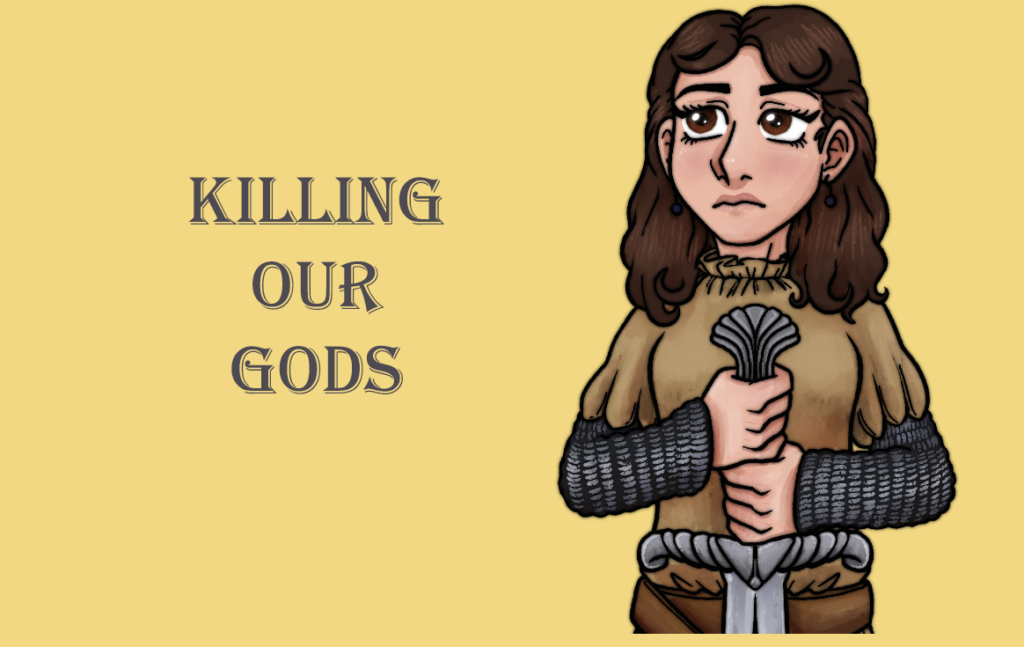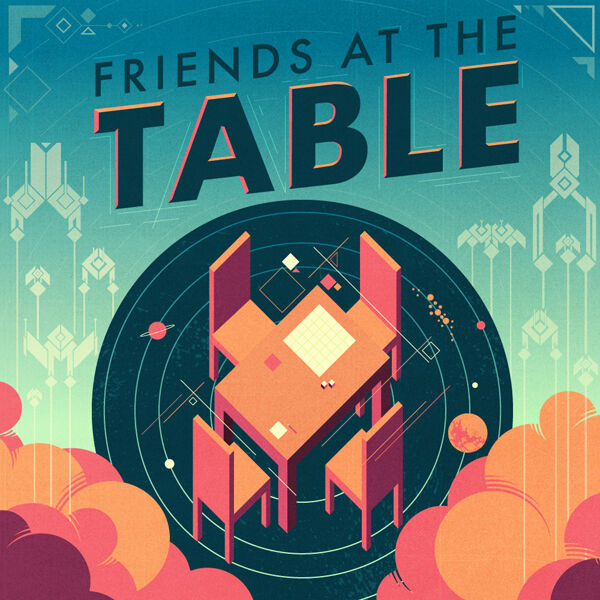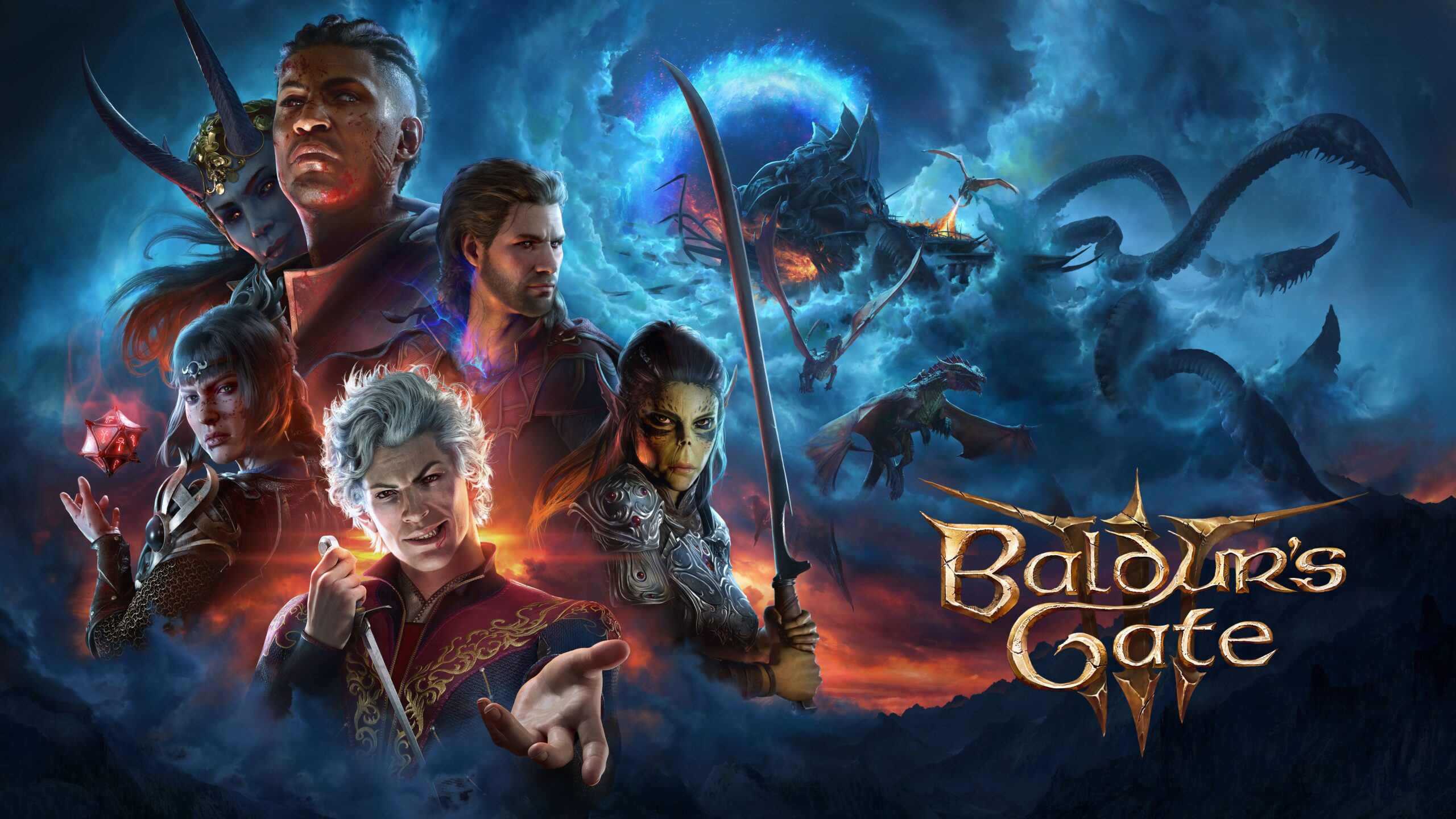
Killing Our Gods: The Shape of Faith
Killing Our Gods is a monthly column from Grace Benfell about Christianity, religion, and role-playing through a queer, Marxist, and lapsed Mormon lens.
Contains spoilers for the entirety of the Friends at the Table season Twilight Mirage.
Once, in full, splendid glory, the ships of the Divine Fleet drifted with their gods. The Divines, machines made to be ideals incarnate, were leaders and servants both. Excerpts were their pilots, living scriptures, the bridge between God and Man. Clocked in the rainbow protection of the Twilight Mirage, a man-made nebula that shields the fleet from harm, this little utopia wandered the stars.
Now, the fleet is in decline. A pantheon of 300 machine gods reduced to a handful through a combination of neglect and outright malice. The fleet has sent a boarding party to colonize the nearby system of Quire, but find, of course, that there is so much living there already. With leadership and options dwindling, the faith of the divine fleet wavers.
So opens the fourth season of actual play podcast, Friends at the Table, entitled Twilight Mirage. While this decay affects every one of Twilight Mirage’s 7 principle characters, the one that felt closest to me after hours of listening was Signet, played by Janine Hawkins. Signet is a former excerpt, pilot of Belgard, a sleek and protective insect-like divine. Belgard died after she asked Signet to abandon her in battle, not wanting another one of her pilots to die. She remains an important figure in the fleet, as a secret agent and aide to the Cadent, leader of the mirage, but her god is dead.
Describing Twilight Mirage requires this much summary because, frankly, it is dense and hard to follow. However, it is that exact density that enables it to be such a moving landscape of faith. Like much of my favorite speculative fiction, Twilight Mirage builds metaphors that are both specific and malleable, and thus ring with profound resonance. The divines are a freeing metaphor because they are both built and exist beyond their builders. They become something more, something that exists beyond the intentions of their creators. A central conflict of the season is that Divines are sentient beings that are also machines. They have an immense capacity to materially help billions of people, but are also beings with their own minds. Their power makes them ripe to abuse and to be abused.

At its broadest, it feels like an apt metaphor for faith. Each divine is given life by its name, a virtue or an action. Library, Discovery, Grace (no relation), and Gumption are some of Friends at the Table’s central massive robots. Just like the ideals that name them, Divines can serve many functions. For the Divine Fleet, they were both symbols and important social infrastructure. In another season, Counter/Weight, the massive divine Rigour is the central villain. One of the first divines in the divine fleet, Independence, left in the early years, crashing into Quire and sparking a planet-destroying war. In contrast, Divines like Bounty feed worlds. Just as some faith pushed crusades and allowed racism and homophobia to fester at its heart, just as some donates to soup kitchens and provides organization for the marginalized, the divines are not one thing. Even a single divine can represent a multiplicity all at once.
Signet, though, lives in the shadow of the responsibility she failed. The faint whispers of Belgard linger, no longer fully divine but not fully perished. She is in the process of deciding what the divine is, and what it will mean to bring a god back. Signet stands at the center of new possibilities, under the monuments of the dead.
Losing faith can feel like this. Whether gradually or quickly, losing faith leaves a hole. Its effects linger, on your mannerisms, your morals, and your habits. If your god is dead, you still live under the hill where it is buried. It can feel like you are in a cocoon, waiting for a new faith to transform you.
But faith is not so predictable and we cannot wait on it. Even if it is as steadfast as rock, rock erodes, rivers carve it into new forms. There is no static way to live in faith. It moves us by nature. While it feels foolish to say that my trans, socialist self comes from my past, there is truth to it. I once believed in a radical ability to change. I believed in a community that cared and looked out for each other. When those things failed me, I found them somewhere else. I am sometimes convinced that my faith has not been lost, it just changed shape.
Belgard’s eventual return to life reflects the process of coming into new faith.Through circumstances too complicated to summarize here, Belgard melds with another new artificial being. This, plus a revitalized knowledge of past divines, gives it life again. Belgard resurrects through both old and new ideals of faith. She is not the same being that she once was, but neither is she completely new.
Fittingly, Belgard’s resurrection comes at a time of change for the Divine Fleet. In an event known as the Miracle of the Mirage, the living, sentient planet Quire splits into 8. This change creates all new factional conflicts. The Divine Fleet becomes The Divine Free States. There is a new push by the native peoples of Quire to take their home back from the off-world colonizers. Having just restored her god, Signet throws herself, once again, into the contradictions of faith. She joins a group called The Notion, with her former boss, the Cadent, in an attempt to unite the system and build something new from the legacy of the Divine Fleet.
My own faith waxed and waned. I remember weeping when a church leader assured me that despite my doubts I was good enough. I remember sitting among other queer students and feeling what I then would have described as the spirit. In the space of hours I would alternate between believing that I could be a member and that I could not. As old and new mingled in my heart, I felt the strain of new life, of new faith.
In time, though, Signet doubts her new role. The Qui Err coalition, a group of Quire’s oldest inhabitants and cultures, respond to the Notion’s promises with skepticism and even hostility. The fascist threat of Advent rises in the sector and the Notion proves unable to stop it. A new Cadent, with a strong claim to the origins of the Divine Fleet arises in the sector. Again, Signet makes the choice to leave it behind.
Before she can, though, her leader, the Cadent confronts her, in a scene that reduced me to tears. Signet claims that “I, for as long as I can remember, have been committed to the same thing. And that thing has served under different mastheads, or different banners. It’s served a lot of different leaders and a lot of different people. I am still committed to that.” It is an assertion that, after all of this, her faith has only changed shape. Though the legend of the divine fleet can feel stagnant, it represents thousands of years of change. Things have changed now, I have changed, but I am committed to the same things I was.
The Cadent responds in anger. She attempts to deny that Signet can leave and still be a part of this faith: “The Fleet didn’t exist once. The Fleet was always being built. Slowly… Every moment was a verification, living, that the project was worth it…recognize the irony that once, a long time ago, you fled to leave Belgard to die, and now both of you would do the same.” This is the voice of a woman who has lost so much, begging one more person to believe in what she does. Worst of all there is truth in what she says. If no one believes that things can be better, nothing will be.
The recognition tugged at me so hard it hurt. I was taught in Mormonism that I have a responsibility to this community, to its children, to my future children. Have I abandoned them? Now, I think a lot about young queer kids. In communities that abuse and degrade them, without mentors or friends to turn to, how can they know that there is a life for them? What can I do for them now that I have left this all behind? Though pleading with someone to stay is never a good idea, it can come from an honest place. What will I do, how I can live in faith, without you? It is cruel to imagine the struggle of faith, without those in the community who share in that struggle. If everyone with doubts leaves, only the zealous remain.
However, faith has its surprises yet. Even now, I feel a connection and a kinship to those who struggle within and without Mormonism. I have a responsibility to them, just as they have a responsibility to me. We cannot free ourselves from it, but we can free ourselves with it. Signet joins the other Cadant, seeing in her, despite innumerable ideological differences, a shared faith and a possibility for change. There are many Mormons who are my friends. I know that we can be comrades in arms, and that we can heal ourselves together. I respect Signet’s choice, even though it could not be mine. Ultimately, we both believe in faith’s power to transform.
It is that multiplicity that I find so alluring about the Mirage. Over the course of the season, several of the characters make gods, become gods, or get resurrected only to die again. Lives are made in the worship of dead divines. Sometimes are unambiguously evil, yes. Advent turns the corpses of divines into war minds. Independence resurrects to force the Quire system into submission. The once liberating symbols of the divine fleet turn into fascist leaders millennia later. That is not the whole story. With the shattering of the Divine Fleet came a multitude of distinct, but connected, communities. That is the utopia I long for. Faith that does not entrap, but embolden. Unity that works through difference, not without it. It is not perfect and it will take time. But I believe my faith community can be like that.
Signet is a well drawn, and thus flawed, character. She is obsessed with reform, content to be cold and alone, to float in and out of people’s lives, to help and then leave. However, her navigation through the shifting, rainbow world of Twilight Mirage, reminds me of faith’s power to make something new, to change and yet remain the same. Though we dwell in cocoons we shall someday burst forth. Our divinity reconstituted, our wounds made into weapons, our selves healed whole.






Sorry, but this was a fucking brilliant read. Bravo.